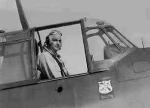You can log-in or register for a user account here.
Commander Robert H. Isely

Robert Henry Isely was born on Christmas Day 1909 in Cimarron, Kansas and attended public schools in Dodge City. In 1929, he entered the U.S. Naval Academy at Annapolis and was graduated from that institution in 1933.
 For the next four years, Lieutenant Isely served aboard various Naval war ships in the Pacific, Atlantic and Carribean areas. In 1937, he underwent aviation training at the Naval Air Station in Pensacola, Florida, and was designated a naval aviator in December of that same year.
For the next four years, Lieutenant Isely served aboard various Naval war ships in the Pacific, Atlantic and Carribean areas. In 1937, he underwent aviation training at the Naval Air Station in Pensacola, Florida, and was designated a naval aviator in December of that same year.
By late 1943, Robert H. Isely had been promoted to the rank of Commander and was designated Commanding Officer of VT-16 (Torpedo Squadron), aboard the Carrier U.S.S. Lexington which was a part of Task Force 58. Over the next ten months, VT-16 carried out bombing raids against Japanese facilities at Tarawa, Wake, Kwajalein, Mille, Palau Truk and Hollandia. On June 13, 1944, Commander Isely led his squadron on a pre-invasion bombing attack against the Japanese airbase at Aslito on Saipan. While carrying out a low altitude bombing run, Commander Isely's TBF Avenger was hit by Japanese anti-aircraft fire and crashed in flames at the south edge of the runway. In recognition of his supreme sacrifice, Commander Isely was posthumously awarded the Distinguished Flying Cross and the Navy Cross. Following the capture of Saipan by U.S. forces, the former Japanese airbase at Aslito was renamed Isely Field in his honor. On June 13, 1994, 50 years after his crash, a Commemorative Plaque for Commander Robert H. Isely was dedicated at Saipan International Airport.
Isely Field
 Isely Field was one of the most important U.S. airbases in the Pacific theater during World War II. Immediately following its capture, Isely Field was used by American fighter aircraft for tactical airstrikes against enemy positions on Saipan and Tinian. Even while the fighting for Saipan raged, Army Engineering battalions began the job of Isely Field on Saipan transforming the former Japanese airfield into a facility capable of accomodating the Very Long Range B-29 Superfortress bomber. Work on Isely Field went on 24 hours a day, seven days a week for the next six months. The first B-29 arrived on Saipan on October 12, 1944 and a month later, Isely Field's twin runways were fully operational. By mid-November, the 73rd Bomb Wing was fully deployed on Saipan and B-29 bombing raids against Japan commenced almost immediately. At the height of combat operations there were approximately 15,000 aircrew and ground support personnel stationed at Isely Field. By war's end, the 73rd had flown 9,897 combat sorties and dropped 48,532 tons of bombs on enemy targets. This impressive record was compiled at the cost of 183 aircraft lost and 1,033 aircrew men killed.
Isely Field was one of the most important U.S. airbases in the Pacific theater during World War II. Immediately following its capture, Isely Field was used by American fighter aircraft for tactical airstrikes against enemy positions on Saipan and Tinian. Even while the fighting for Saipan raged, Army Engineering battalions began the job of Isely Field on Saipan transforming the former Japanese airfield into a facility capable of accomodating the Very Long Range B-29 Superfortress bomber. Work on Isely Field went on 24 hours a day, seven days a week for the next six months. The first B-29 arrived on Saipan on October 12, 1944 and a month later, Isely Field's twin runways were fully operational. By mid-November, the 73rd Bomb Wing was fully deployed on Saipan and B-29 bombing raids against Japan commenced almost immediately. At the height of combat operations there were approximately 15,000 aircrew and ground support personnel stationed at Isely Field. By war's end, the 73rd had flown 9,897 combat sorties and dropped 48,532 tons of bombs on enemy targets. This impressive record was compiled at the cost of 183 aircraft lost and 1,033 aircrew men killed.
Following the surrender of Japan, B-29s from Isely Field were used to drop medical and food supplies to Allied prisoners of war in Japan. With the departure of combat air groups in late 1945, Isely Field was used as an emergency and refueling facility by the 6253 Air Base Unit until 1949 when it was closed. Following World War II, commercial airlines used a landing facility called Kobler Field, three kilometers from Isely Field. By 1968, the Kobler runway had seriously deteriorated and it was decided to move the airport to Isely Field. Construction of the Saipan International Airport, as Isely Field was renamed, began in October of 1973. The first commercial aircraft to land at the new airport arrived on December 15, 1975, thus beginning a new era for historic Isely Field. In recognition of its significance in the prosecution of the Pacific War, the National Park Service in 1985 designated Isely Field as a National Historic Landmark.
| Commander Robert H. Isely | Log-in or register a new user account | 0 Comments | |
|
| |
| Comments are statements made by the person that posted them. They do not necessarily represent the opinions of the site editor. |



